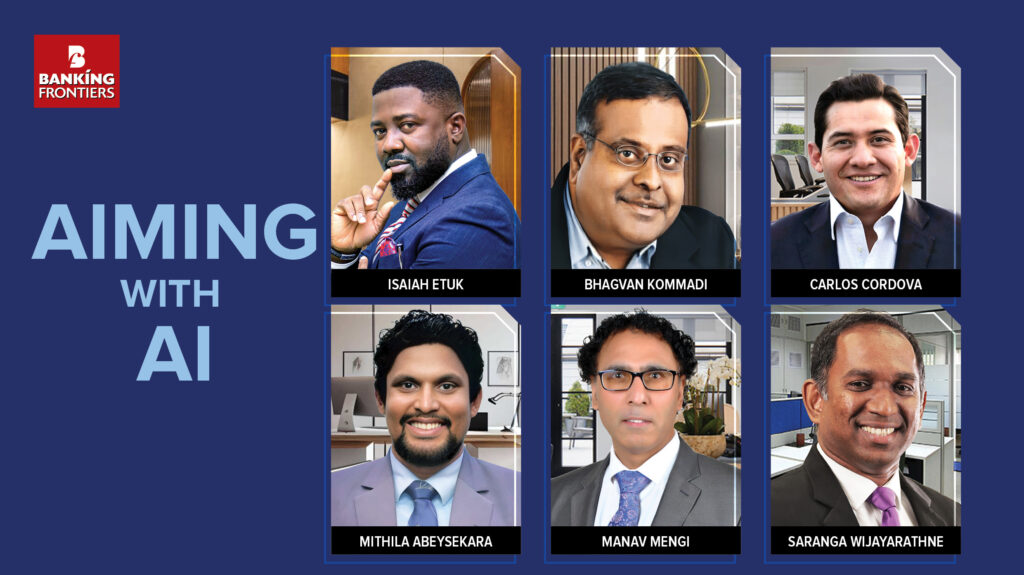Six CIOs/CTOs/CDOs from India, Sri Lanka, Uganda, Nigeria and Ecuador delve into driving back-office progress using Gen AI:

Generative AI is not just revolutionizing front-office interactions; it’s also transforming the often-unseen engine room of businesses: the back office. From streamlining operations to enhancing security and ensuring regulatory compliance, AI/ML is offering significant potential for improvement. But realizing this potential requires a strategic approach, focusing on key success factors. Industry leaders across the globe share their insights.
Focus on Tangible Value and Regulatory Compliance
Isaiah Etuk, Chief Digital Officer at Capital Express Life Assurance in Nigeria, emphasizes the importance of clear business objectives and demonstrable efficiency gains. He advocates for focusing on specific goals, such as automating claims processing, detecting fraud, or streamlining regulatory reporting, and tying each initiative to measurable metrics. He cites examples like a 30% reduction in processing times or a 15% drop in operational costs, ensuring alignment and demonstrable ROI. Etuk stresses that focusing on concrete outcomes keeps teams aligned. He also stresses the critical nature of high-quality data and regulatory compliance under the Nigeria Data Protection Regulation (NDPR), highlighting a case where a thorough data cleansing at a major insurer in Lagos improved underwriting model accuracy by 20%. Such efforts, he notes, not only standardize data but also build trust with stakeholders. He further emphasizes process optimization, risk mitigation, and collaboration with NAICOM to ensure compliance and responsible innovation. He notes that automating repetitive tasks minimizes errors and frees staff for higher-value activities, boosting efficiency, while AI algorithms detect potential fraud and regular audits mitigate bias, strengthening operational integrity.
Core Pillars
Bhagvan Kommadi, CIO of Capri Global Capital, focuses on efficiency, security, and data management as core pillars for back-office AI success. He emphasizes process automation for repetitive tasks like data entry, document verification, and compliance checks, reducing errors and accelerating operations. He notes that AI-ML solutions streamline workflows, significantly reducing cycle times and enhancing productivity, allowing teams to focus on strategic initiatives. Kommadi also stresses fraud detection and prevention through AI-ML models that analyze transaction patterns to identify anomalies indicative of fraudulent activities, safeguarding the organization and its customers. He emphasizes effective data management solutions that ensure accurate processing, storage, and retrieval of information, highlighting compliance measures such as encrypting personally identifiable information (PII), masking PII in reports, and adhering to retention and archival regulations, all efficiently implemented using AI-ML tools. These practices, he believes, enhance regulatory compliance & decision-making capabilities.
Strategic Alignment, Data-Driven Insights, and Predictive Capabilities
Manav Mengi, CIO of Diamond Trust Bank in Uganda, highlights the importance of aligning AI/ML models with strategic objectives, stakeholder collaboration, and continuous application monitoring. He stresses the need for data-driven insights based on high-quality, diverse, and well-curated datasets and the use of AI for scenario simulation and predictive capabilities. He gives examples of using AI-based application monitoring tools to track model performance, detect anomalies, and mitigate risks like model drift, ensuring continuous performance and accurate insights. He notes the importance of open communication channels between stakeholders to refine AI strategies over time. He gives examples of using AI for real-time monitoring, market expansion analysis (analyzing regional economic indicators, customer demographics, and competitive landscapes), and simulating the impact of interest rate changes on loan portfolios, providing strategic foresight. He also mentions using predictive analytics to enable cross-selling and upselling opportunities.
Data Integration, Predictive Maintenance, and Cost Efficiency
Mithila Abeysekara, Chief Technology & Digital Officer at First Capital Holdings in Sri Lanka, focuses on data integration and automation, predictive maintenance and risk management, and cost efficiency. He cites examples of banks like HSBC using AI to automate regulatory reporting, ensuring accuracy and reducing manual effort. He explains how AI can monitor internal systems and predict when maintenance or updates are required, reducing downtime and enhancing reliability. He also notes that AI can detect financial anomalies, preventing systemic failures and safeguarding the institution from risk. Abeysekara emphasizes that by automating repetitive administrative tasks, AI reduces operational costs and frees up resources for strategic initiatives.
Specialized Teams, and Agile Implementation
Carlos Cordova, Chief Digital and Data Officer at a leading insurance company in Ecuador, emphasizes strategic alignment, particularly for back-office solutions that are not directly customer-facing. He highlights the importance of specialized teams with deep technical expertise to navigate challenges like legacy system integration, mentioning a specific challenge his company faced in integrating legacy technology with a new solution, requiring careful planning and coordination to mitigate business continuity risks. He also advocates for a “start small, move quickly” approach, citing a successful MDM solution implementation in just six months with Colombian provider Softka, emphasizing the value of rapid development and iteration. He notes the importance of integrating solutions like MDM with systems like Salesforce CRM, particularly for mass-market channels like bancassurance.
The Bottom Line: A Multifaceted Approach to Back-Office Transformation
While specific priorities may vary, a common thread emerges: successful back-office AI implementation requires a multifaceted approach. Clear business objectives, high-quality data, regulatory compliance, process optimization, and strategic alignment are all crucial. Furthermore, specialized expertise, agile implementation, and continuous monitoring are essential for maximizing the value of AI/ML in the back office. By focusing on these key factors, businesses can unlock significant efficiencies, enhance security, and drive operational excellence.
Recent Articles:
Cracking the Code: Success Factors for Generative AI in the Front Office









